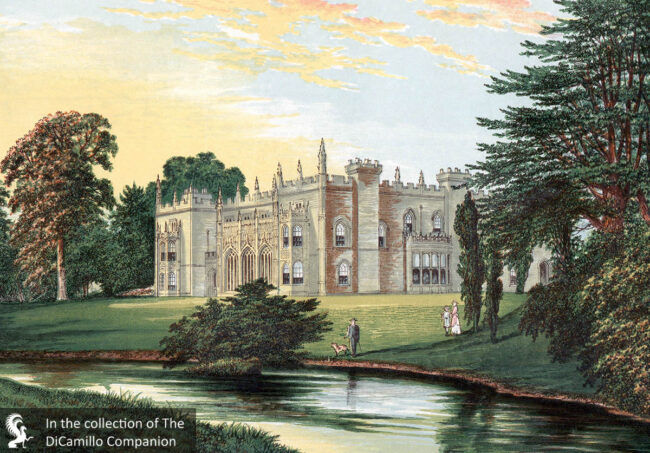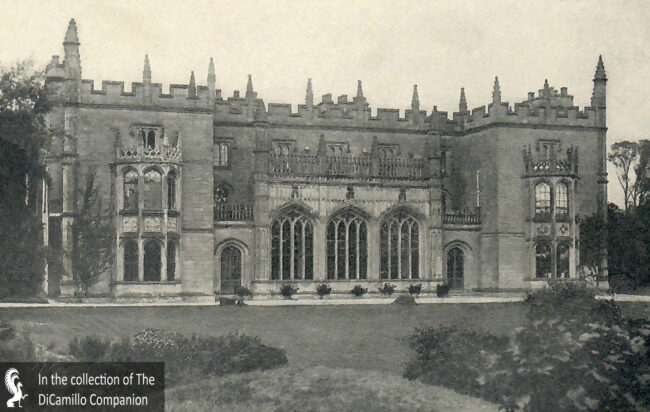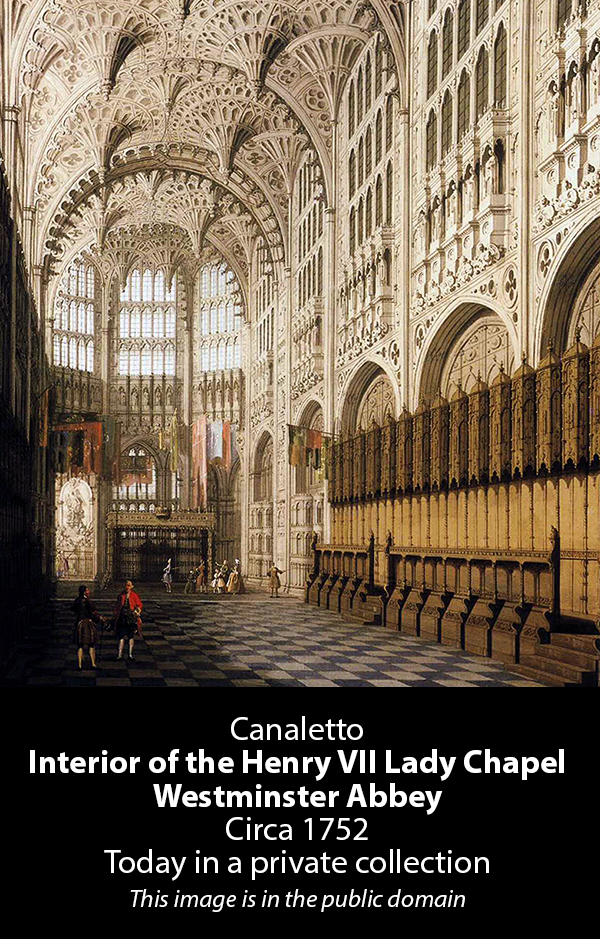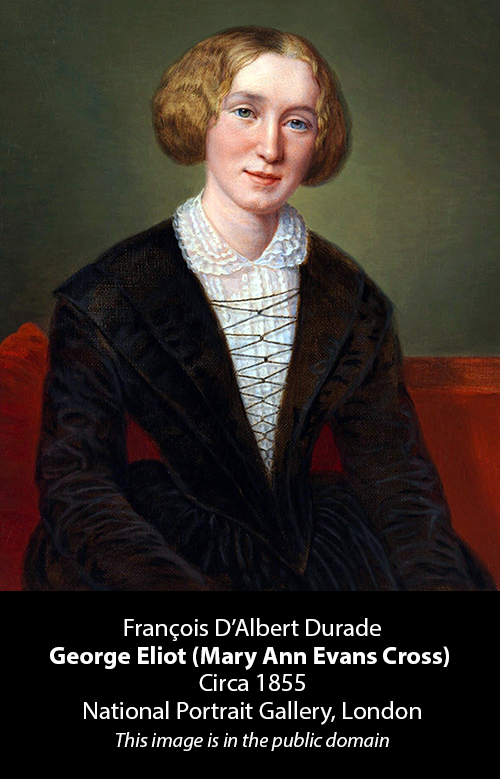
An 1885 print of the house from "Morris's Views of Seats"

The house from a photograph that appeared in a 1901 edition of "Scenes of Clerical Life"

The house from a circa 1919 postcard

The house, from across the lake, from an early 20th century postcard.

The drawing room from a photograph that appeared in a 1901 edition of "Scenes of Clerical Life"

Sir Roger Newdigate in the library at Arbury Hall; from a 1756-58 painting by Arthur Devis. This image is in the public domain.

The inspiration for many of Arbury's Gothic interiors was the Henry VII Lady Chapel at Westminster Abbey. This amazing space, built 1503-16, was called orbis miraculum ("the wonder of the world") after its completion.

The Henry VII Lady Chapel at Westminster Abbey from a circa 1910 postcard. The Arbury saloon was modeled on this famous space.

Earlier Houses: Like many English country houses, Arbury has an ecclesiastical background; in the 14th century, during the reign of Henry II, Ralph de Sudeley founded an Augustinian monastery here. In 1536 the monastery was dissolved by Henry VIII and confiscated by the crown. In 1538 it was granted to Charles Brandon, 1st Duke of Suffolk. During the reign of Queen Elizabeth I Arbury was purchased by Sir Edmund Anderson, a lawyer who demolished the old house and built anew. By 1586 Sir Edmund found Arbury inconvenient for his frequent need to be in London; thus, that year he exchanged the estate for Harefield Place in Middlesex, which was the property of John Newdegate.
Built / Designed For: Sir Edmund Anderson
House & Family History: In the 18th century Sir Roger Newdigate rebuilt his ancestral Elizabethan home into one of the finest examples of the Gothic Revival style in England. Called the “Strawberry Hill of the Midlands,” Arbury Hall is particularly noted for its rich, Gothic interiors inspired by Henry VII’s Lady Chapel at Westminster Abbey (see "Images" section). Built between 1503 and 1516 for King Henry VII, the Perpendicular Gothic style chapel’s interior was so magnificent it caused the 16th century antiquarian John Leland to call it the orbis miraculum (“the wonder of the world”) soon after its completion. Possibly the best example at Arbury of the influence of the Henry VII Chapel is the 18th century saloon, whose pendant fan vault ceiling is jaw-dropping in its magnificence. Sir Roger, a wealthy landowner, patron of the arts, and MP, is remembered today for the Newdigate Prize, which he founded and endowed in 1805. Awarded each year by the University of Oxford for the best student poem of up to 300 lines on a given subject, the prize has been given to several literary notables, including John Ruskin and Andrew Motion, the British poet laureate from 1999 until 2009. Sir Roger also has very good classical scholarly claims: he made a drawing of the Roman arch at Aosta that was used in 1774 by Piranesi as the basis for an engraving, and, in 1776, Sir Roger presented to the University of Oxford two candelabrum reconstructed by Piranesi from antique fragments. George Eliot was born on the Arbury Estate, where her father was for many years the agent. Sir Roger Newdigate (and Arubury Hall) was immortalized in Eliot's first published book of fiction, 1857's "Scenes of Clerical Life," where he appears as Sir Christopher Cheverel in "Mr. Gilfil's Love Story." In a gesture of respect for her international fame, in 1911 Sir Francis Alexander Newdigate-Newdegate erected a monument to George Eliot on the grounds of Arbury Hall.
Collections: The Long Gallery contains the chair and table used by Henry Grey, 1st Duke of Suffolk, father of Lady Jane Grey.
Comments: Arbury, one of the most complete and best-preserved Gothic Revival houses in England, is often called the "Gothic Gem of the Midlands," or the "Strawberry Hill of the Midlands." Pevsner called the house "one of the finest examples of the early Gothic Revival in England."
Garden & Outbuildings: The house sits in the middle of a 300-acre park populated with lakes and woods with rhododendrons, azaleas, and giant wisteria. The circa 1674 stableblock, attributed to Sir Christopher Wren, is one of the architect's few works outside London. At Caumsett, the 1920s Marshall Field II estate on New York's Long Island, architect John Russell Pope designed the stables in emulation of Wren's stableblock at Arbury.
Architect: William Hiorne (Hiorns)
Date: Circa 1748Architect: Henry Keene
Date: Circa 1761Architect: Henry Couchman
Date: 1776-89Architect: Sanderson Miller
Date: Circa 1750-52Architect: William Wilson
Date: Circa 1675Architect: Christopher Wren
Date: Circa 1674Architect: Roger Newdigate
Date: 1750-90John Bernard (J.B.) Burke, published under the title of A Visitation of the Seats and Arms of the Noblemen and Gentlemen of Great Britain and Ireland, among other titles: Vol. II, p. 13, 1853.
Country Life: XXXIV, 356, 1913. CXIV, 1126, 1210, 1414, 1953.
Title: John Russell Pope: Architect of Empire
Author: Bedford, Steven McLeod
Year Published: 1998
Reference: pg. 92
Publisher: New York: Rizzoli International Publications, Inc.
ISBN: 0847820866
Book Type: Hardback
Title: Arbury Hall Guidebook - 1985
Author: NA
Year Published: 1985
Reference: pgs. 1, 10, 13, 14, 15
Publisher: Derby: English Life Publications
ISBN: 0851012485
Book Type: Light Softback
Title: Biographical Dictionary of British Architects, 1600-1840, A - SOFTBACK
Author: Colvin, Howard
Year Published: 1995
Reference: pgs. 496, 497, 573, 654, 699, 1064, 1091
Publisher: New Haven: Yale University Press
ISBN: 0300072074
Book Type: Softback
Title: Best Buildings of England, The
Author: Pevsner, Nikolaus
Year Published: 1986
Publisher: London: Viking
ISBN: 0670812838
Book Type: Hardback
House Listed: Grade I
Park Listed: Grade II*
Current Seat / Home of: James Edward FitzRoy-Newdegate, 4th Viscount Daventry; Newdegate (Newdigate) family here since the 16th century.
Past Seat / Home of: SEATED AT EARLIER HOUSE: Charles Brandon, 1st Duke of Suffolk and 1st Viscount Lisle, 16th century. SEATED AT CURRENT HOUSE: Sir Edmund Anderson, 16th century. Sir John Newdegate, until 1610; Sir Richard Newdigate, 1st Bt., 1642-78; Sir Richard Newdigate, 2nd Bt., 1678-1710; Sir Richard Newdigate, 3rd Bt., 1710-27; Sir Edward Newdigate, 4th Bt., 1727-32; Sir Roger Newdigate, 5th Bt., 1732-1806; Francis Parker-Newdigate, 1806-62; Lieutenant-General Sir Edward Newdigate-Newdegate, 1887-1902; Sir Francis Alexander Newdigate-Newdegate, 1902-1936; John Maurice Fitzroy-Newdegate, 1936-76; Francis Humphrey Maurice FitzRoy-Newdegate, 3rd Viscount Daventry, 1976-2000.
Current Ownership Type: Individual / Family Trust
Primary Current Ownership Use: Private Home
House Open to Public: Yes
Phone: 01676-540-529
Fax: 02476-641-147
Email: [email protected]
Website: https://arburyestate.co.uk/
Historic Houses Member: Yes